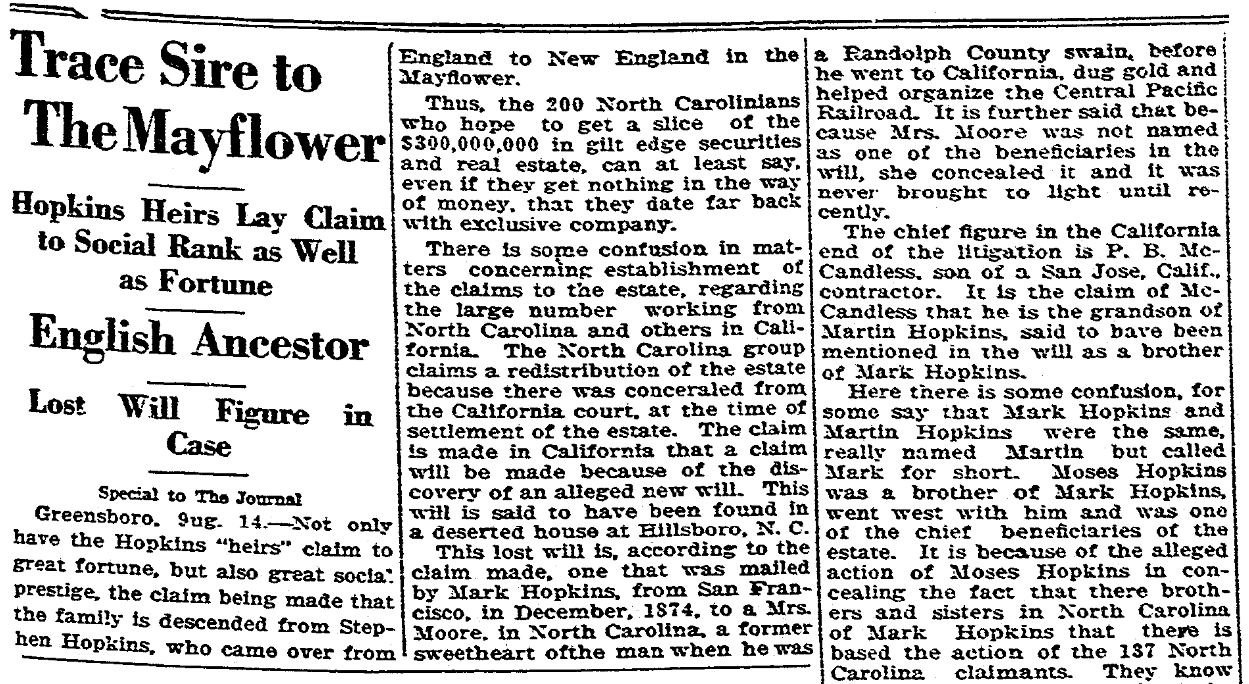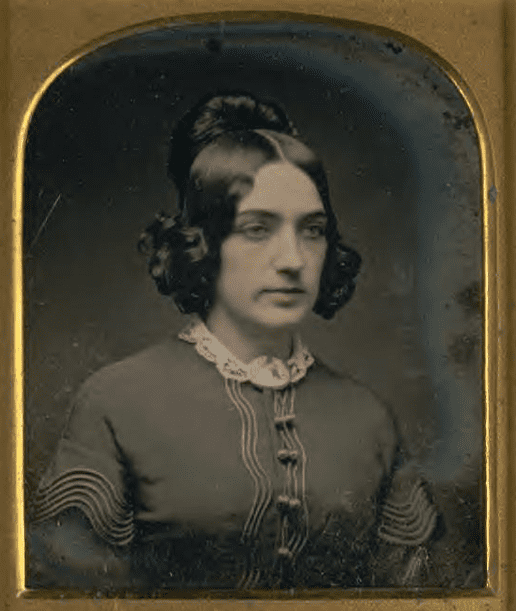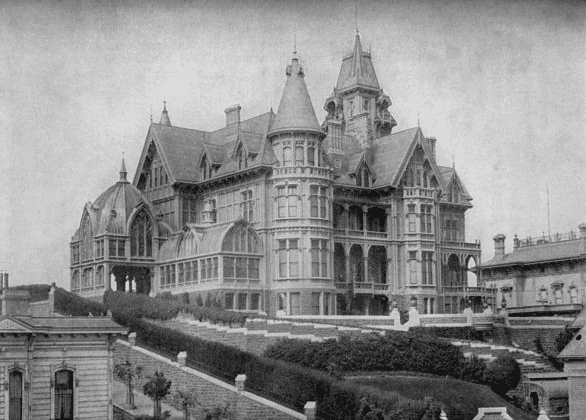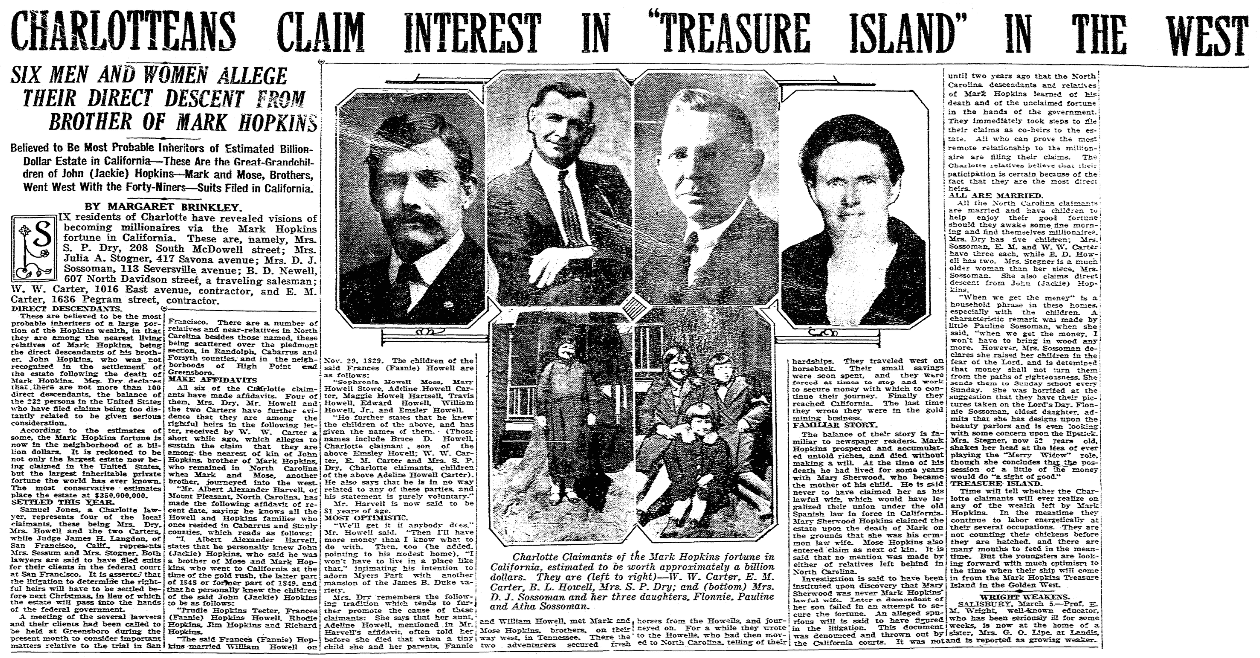Introduction: In this article, Melissa Davenport Berry writes about the probate battles over the huge estate left by railroad magnate Mark Hopkins. Melissa is a genealogist who has a website, americana-archives.com, and a Facebook group, New England Family Genealogy and History.
When California railroad tycoon Mark Hopkins died in 1878 his estate was the largest inheritable fortune ever in the world. He died intestate and without an heir. His wife Mary was duly appointed administratrix and adopted the son of her maid, which provided an heir.

She was dubbed “America’s Richest Widow” by the press, who loved to chronicle her extravagant and eccentric lifestyle. Mary erected mansions and hosted seances. She “cougared” her interior decorator, which resulted in a scandalous marriage.
Mary died in 1891 and the estate was battled out in probate court between young hubbie and a disinherited son. Mark Hopkins’ estate was later called into question by a swarm of Hopkins hopefuls in the 1920s who turned up with bogus pedigrees, fake wills, and forged Bibles that claimed a genealogical connection to the magnate. The newspaper headlines screamed “A New Gold Rush Is On!”

Mark Hopkins, the “Vanderbilt of the Pacific Slope,” was a true pioneer and a “49er.” He sailed on the ship Pacific from New York City on 22 January 1849 to seek his fortune in California. He started the New England Mining and Trading Company with a group of 26 men, who each invested $500 to purchase goods and ship them to California for sale.
He was one of the “Big Four” that formed the Central Pacific Railroad, along with Leland Stanford, Charles Crocker, and Collis Huntington.
Mark married his cousin Mary Frances Sherwood on 22 September 1854 in New York City. Their family lineage can be traced back to Mayflower passengers, settlers of Massachusetts Bay Colony and Connecticut.

Mary loved romance novels and castles. Mark “liked hard work more than the laziest man liked to loaf.” He was known as “Uncle” Mark by his partners, who relied on his even temperament and solid business sense.
Mark was the anchor for many, including Timothy Nolan, the son of his widowed housekeeper. Timothy became part of Mark’s household early on and he groomed the young lad for business and Harvard. When Mark Hopkins died in 1878, plans for attending college were cancelled and Timothy’s life was altered forever. He would play a convenient role for Mary Hopkins and her financial affairs.
On 21 May 1878 Mary Hopkins filed a petition in the San Francisco County Court for letters of administration. She received most of her husband’s estate, and a portion was given to brothers Samuel Frederick Hopkins of Michigan and Moses Hopkins of California. She also adopted Timothy Nolan and he became the Hopkins’ official heir.
Soon after the estate was settled Mary moved into a mansion on Nob Hill, San Francisco, and retained the Herter Brothers firm of New York to decorate her palace. The papers noted “America’s Richest Widow” was living it up large in her fancy mansion and traveling like a princess in her Midland Railway “Drawing Room Car” to New York.

Mary told the press that she loved to indulge Timothy with all his desires. She spent $7,000 on rare books on one shopping trip to New York, hoping to encourage Timothy’s reading. Timothy loved his new digs and told the press: “My room is magnificent, and I just gave Herter carte-blanche, and suits of armor are hung up on the walls, he has made it look like a castle.”
Meanwhile, the courts were swamped with letters from chaps who claimed Hopkins promised to adopt them too, and one Midwest woman lay claim for $1,000,000 that she said the railroad man had promised he would leave for her. This would be just a taste of what would come later.

Mary encouraged Timothy to do his apprenticeship with Central Pacific Railroad and to marry her niece, Mary Kellogg Crittenden. The couple married on 28 November 1882. For a wedding gift Mary purchased Governor Milton Lathrop’s estate at Menlo Park and named it Sherwood Hall. She hired the Herter Brothers firm again to decorate.
Herter sent out a young interior decorator from Massachusetts… I think you know where this is going. Check back tomorrow for Part 2 of this story!
Note: Just as an online collection of newspapers, such as GenealogyBank’s Historical Newspaper Archives, told the stories of Mark Hopkins’ life, they can tell you stories about your ancestors that can’t be found anywhere else. Come look today and see what you can discover!
Genealogy:
- Mark Hopkins (1813-1878), son of Mark Hopkins (1779-1828) and Anastasia Lukins Kellogg (1783-1834), who are first cousins. Mark’s siblings: Samuel Frederick Hopkins (1803-1884), Henry Kellogg Hopkins (1807-1846), Moses Hopkins (1817-1892) and Ezra Augustus Hopkins (1821-1865).
- Mark married first cousin Mary Frances Sherwood (1818-1891), daughter of William Sherwood (1786-1871) and Lydia Ann Kellogg (1793-1865).
Others in the family tree:
- Moses Hopkins (1751-1838) and Ann Whiting (1754-1834).
- Ezra Augustus Kellogg (1754-1833) and Mary Whiting (1758-1837).
- Samuel Hopkins (1721-1803) and Joanna Ingersoll (1726-1793).
- Captain Timothy Hopkins (1691-1749) and Mary Judd (1701-1774).
- John Hopkins (1662-1732) and Hannah Strong (1660-1730).
- Stephen Hopkins (1631-1689) and Dorcas Brown (1633-1697).
- John Hopkins (1613-1697) and Jane Strong (1615-1679).
Elizabeth Needham, genealogist and Mayflower Society member, confirmed the genealogy for Mayflower line connections which also include:
- John Tilley and Joan Hurst Tilley; daughter Elizabeth Tilley married John Howland and daughter Desire Howland married John Gorham.
- William Bradford and second wife Alice Southworth Carpenter; son Major William Bradford and wife Alice Richards.
- Thomas Rogers and Alice Gosford; son John Rogers married Anna Churchman and had son Rev. John Rogers, married to Elizabeth Peabodie.
Other direct lines include:
- William Whiting, early settler of Hartford, Connecticut; and John Gillette, an early resident of Canaan, Connecticut.
- Timothy Nolan (1859-1936) was born to Irish immigrants Patrick Nolan (1829-1862) and Catherine Fallon (1834-1903) in Augusta, Maine. (Harold Clarke Durrell, “Memoirs of Deceased Members of the New England Historic Genealogical Society” NEHG Register April 1936.) He married Mary Kellogg Crittenden (1862-1941), daughter of Hiram Crittenden (1814-1883) and Lydia Sherwood (1829-1877). They had one daughter, Lydia Kellogg Hopkins (1887-1965).
- Timothy Hopkins was a member of the New England Historic Genealogical Society and produced genealogies; one was a three-volume series, “The Kelloggs in the Old World and the New” and “John Hopkins and Some of His Descendants.” His wife Mary was a member of the Daughters of the American Revolution, the Mayflower Society, and the Colonial Dames.
Research Sources and Aids:
- Heather Wilkinson Rojo has a great resource page on her blog Nutfield Genealogy Ten Things to Know About Researching a Pilgrim in Your Family Tree.
- “The Inside Man: The Life and Times of Mark Hopkins of New York, Michigan, and California, Volume 1” Salvador A. Ramirez, 2007.
- The Mark Hopkins Mansion.
- THE “BIG FOUR”.
- Stanford University: Timothy Nolan Hopkins.

Excellent! Thank you for the reference.
Thanks Elizabeth for Mayflower genealogy! This was fun discussing
Interesting read.
Thanks Sallie! I appreciate it and I found Cass family mingling at Kellogg Terrace I will send
Hi, is this Crittenden family originally from Cranbrook, Kent, England? I have DNA matches for Crittenden and Chittenden. And Chuttinden in my tree.
Hi Chris Where did they settle? I believe this line was mostly in New York and Massachusetts Thanks for reading and sharing!
Great story and research! Fascinating history!!!
Thanks Beth and I hope to use some of your amazing photos in the blog one day!
Hello,
Stephen Hopkins and Dorcas Bronson are my 9th great grandparents.
Jane I just sent a correction on the Hopkins line I know Stephen was a founder of Connecticut. I would love to hear more about him! Thanks
Great story, can’t wait for more of the story!
Thanks Jeff! I keep finding more scandal with this one!
Fast moving story! No wonder the press was all over it.
Thanks William. I have much more coming on Hopkins and it is a big scandal! So stay tuned!
Melissa, I enjoyed reading your articles on the Hopkins family and the rush for a part of his estate. For 40 years I have been tracing my family and I heard through 4 sources (no longer living) that some of my descendants put in a claim for the estate. Although I doubt that my family (who emigrated from Guilford Co., NC, in 1832) have any true connection with the famous Mark Hopkins, I would love to see their claim letters — it might help me establish my Hopkins line before 1800. Do these papers — these claims or requests for part of the estate (over a thousand I read) — still exist? If so where are they held and would I be able to research them? Thank you for any lead.
Hi Michael,
Thank you! And there were many Hopkins in North Carolina that were part of the claimants who had Virginia ties too. The Edward “Ned” Hopkins and Hannah Crow line was one. More coming soon! Thanks for reading and try to do a search on GenealogyBank for articles on Hopkins.
The story of the money doesn’t end there, of course. It was mentioned that the widow, Mrs. Hopkins, who eventually inherited most of it, had engaged the notable Herter Brothers of New York to decorate the sumptuous mansion she built. They sent one of their leading interior decorators, Edward Francis Searles (1841-1920) to California to oversee the work. Searles, the son of a poor farmer of Methuen, MA, had, by dint of his artistic talents, worked his way up in the Herter firm. The two soon realized that they shared many tastes and interests. In addition, both were native to Massachusetts, and Mrs. Hopkins longed to return to the state, having many relatives in the western area near Great Barrington. The end result was that she is said to have proposed to Searles, who was a bachelor; he initially refused, as she was older than he, but soon consented. She then put him in charge of building and decorating a “summer mansion” in western MA, as well as a winter residence in Searles’s home town. They soon were enjoying social and musical activities at both, along with travels in Europe. She predeceased him, however (and is buried in Methuen) and since again childless, another big and well documented money battle ensued, although Searles was the eventual inheritor. He became something of a recluse, but was generous to his hometown by providing it with handsome architectural gems including a high school, a concert hall, a few churches, a fire house, an inn, a library, and even an organ and bell factory (he loved music, and so did she). Incidentally, I live near Methuen and am presently a member of the board of trustees of Methuen Memorial Music Hall, built by Searles in 1909, and today a civic cultural asset.
Barbara,
Thank you so much. I will contact you as I found articles on GenealogyBank about the Metheun connection with the families. I will be covering this in an article in the near future. I know there was an organ brought to his Metheun home from the house in Great Barrington, MA. I look forward to connecting and sharing.
Fascinating tale plus…
Moses Hopkins married Emily Benedict from Norwalk, Ct, whose older sister(?), Anna Louise, was married to LeGrand Lockwood — who commissioned Detlef Lienau to design and Herter Brothers to decorate his Norwalk mansion, now the Lockwood Mathews Mansion Museum in Norwalk, a National Historic Landmark. Emily Hopkins sued her much older husband, Moses, for alienation of affection when he allegedly had an affair with his hairdresser. Then he died.
Can you corroborate this? I did the research in the 1980s and cannot find the newspaper articles online that describe the trial.
Mimi,
I did see some articles on GenealogyBank when I researched Mark Hopkins and I will be covering more on this story soon. Have you tried researching Emily Hopkins on the GenealogyBank site for newspaper coverage? I believe one died in 1925. More on the Hopkins lines will be coming!
Very interesting!
Thank you Angela! Stay tuned!
My great grandmother was Jennie Ora Hopkins (1867-1948) who claimed she was cheated out of the family fortune. Whatever that meant. Her father was John Orlando Hopkins (1824-1907). His father was Cyrus Hopkins, born in Great Barrington, Mass. (1782-1863). His father was Ichabod Hopkins (1744-d. 1819 Great Barrington). His father was Timothy Hopkins (1723-d.1774 Great Barrington). His father was Timothy Hopkins (1691-1748). If I recall correctly, Mark Hopkins’ widow built a home in Great Barrington.
Hi Steve,
Thanks for commenting, and we will be publishing an article on the Great Barrington family line very soon. There is already a story on the site on Kellogg Terrace, the mansion Mary Hopkins built with Edward Searles. My next post will cover Mary Hopkins’ restoration of the graveyard which maybe is where your ancestors are buried. Stay Tuned!
Very interesting read. My Great grandfather Henry I. Keeling was a coal and railroad man in Pittsburgh, Pa. My other Grandfather worked for the Pennsylvania Railroad. My Grandmother and I rode the train for years free.
Thanks Carol! Was Henry related to Rev. Henry Keeling, who was married to Jane Charlton? Pennsylvania is filled with great history! I went to Hanna’s Town this summer for a Civil War reenactment. Pittsburgh is not too far. Hope to cover some stories for the blog.
I believe I’m related to Rev. Henry Keeling but I have so much information that needs more studying. He was in the Princess Ann Colony in Virginia. My family is very large, and I’ve been looking more into the Native American Indian (Allen) side of my family.
Hi Carol,
I am working on all the lines who were listed in the papers and court documents, and will let you know if I come across. Have you searched GenealogyBank yet? Thanks so much!
My Hopkins family was approached by attorneys in the 1920s telling them they had claim to part of Mark Hopkins’ fortune. I have been researching my Hopkins family for many years and do not show a lineage to Mark Hopkins. My Hopkins family were poor farmers living in OK. Can you imagine being a poor farmer and being told you are going to inherit millions of dollars? I can’t imagine! The attorneys had them convinced that Mark was their cousin, so they called him cousin Mark. I have copies of letters my family wrote to each other during this time period. Fascinating to read.
Hi Renee, I am working on more of the families who were part of the Mark Hopkins claims. Please check back, but if you could please post the family lines that were contacted. Thanks so much!
Very interesting article! I look forward to the continuation of the Mark Hopkins story! I helped my next-door neighbor years ago research her Hopkins line beginning with a Stephen Hopkins in Pendleton District, S.C. 4 Feb. 1813, Pendleton District, S.C., a Deed of gift land, cows, furniture, etc., to his children: David Hudson Hopkins, Benjamin Franklin Hopkins, John Hubbard Hopkins, Rhoda Peeples Hopkins, Nancy A. Hopkins and Patsy Taylor. By 1830 no Stephen. An older woman, Nancy Hopkins, (b. Va.) is living near Stephen’s sons. A crazy mixed-up line for sure!
When I asked her what info she had, she pulled out copies from her grandmother. Lo and behold — a family tree with a Mark Hopkins and brother, Moses Hopkins. A letter from a lawyer who went out to California with “proof” in the form of a Bible, births, deaths, marriages, etc. On the way back he mysteriously died on the train. The Bible disappeared. Many hours of S.C. research, five thick files, and no answers as to who Stephen Hopkins was!
Linda — Wow! That is quite a story! I will have to look up some of these names. Is Doris Taylor, who worked with Estelle Latta on the legal claim, related to Patsy Taylor? I am working on more posts and they will be up soon. Thank you so much for sharing!
I was unable to find anything on Patsy Taylor at all. I have so much more but impossible to type it all here. I am happy to share. Maybe I can get a “who begot who” summary and post on this blog.
Ms. Berry, Will you be going through the records held at the California Historical Society, North Baker Research Library, San Francisco? I wrote in 2001 to ask if they would look for anything relating to the Stephen Hopkins of S.C. They replied there were too many records and invited me to come there to search. Would love to know what is there!